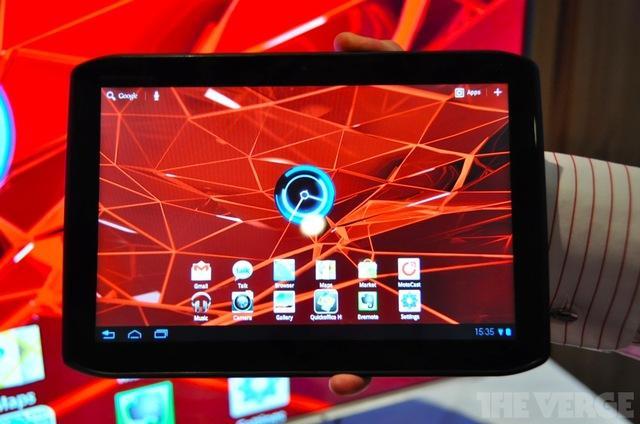
If you can recall back to before the launch of the Motorola XOOM on Verizon Wireless, you likely remember that it was expected to be the first true contender to the iPad. For all intents and purposes, it was. After all, it was the first truly high-end Android tablet to make it to market. But the XOOM was more or less a flop – a great device with potential that fell victim to terrible marketing, a terrible launch/upgrade plan and horrendous pricing.
In terms of specifications, the XOOM is not a bad device at all. Sure, it's a bit chunky in comparison to the Galaxy Tab 10.1 or ASUS Eee Pad Transformer. But it carries much of the same specs: 1GHz Tegra 2 dual-core processor, 1GB RAM, 10.1-inch (1280 by 800 pixels) display, 5-megapixel rear camera and a 2-megapixel front shooter. It also shipped with 32GB built-in storage and in either a Wi-Fi only (which also comes in a 16GB version) or Verizon 4G LTE flavors.
Like I mentioned above, the problem was not specs or performance, but price. Originally, the XOOM was $599.99 with a two-year agreement and $799.99 contract-free, and only came in one flavor. Ouch. After being stonewalled by customers and sales not meeting expectations, Motorola and Verizon decided to drop the price to something a bit more reasonable. With a two-year agreement with Verizon, the 32GB XOOM will now set you back $299.99; sans contract, it will cost you $669.99.
In short, the Motorola XOOM was not – by any stretch of the term – an iPad killer, and it wasn't nearly what we Android fans were hoping for or expecting.
Anyway, it has been 10 months since the XOOM first launched, which means we're due for a successor. This morning, we were met with an official announcement and launch of five different flavors of the Motorola DROID XYBOARD. And I am completely and totally unsurprised that Motorola and Verizon have missed the mark ... again.
The tablet market is bursting at the seams. Manufacturers are launching tablets left and right, all in different price ranges and with varying specifications. To date, hitting the $500 price mark and below has really been the only thing to work in Android tablets' favor. The 8.2-inch 16GB XYBOARD does ship for $429.99, and the 10.1-inch flavor, which has proven to be the most popular Android tablet size, starts at $529.99. Did I mention those are contracted prices? That's right, $429.99 or $529.99 with a two-year agreement. Respectively, without a contract, those tablets will cost $599.99 and $699.99. The largest of the XYBOARDs, the 10.1-inch 64GB version, will set you back $729.99 with contract or $899.99 contract-free.
If you're not looking to buy a tablet with a two-year agreement, the XYBOARD just went entirely out the window as a possibility. Who would possibly want a 16GB Android tablet for $699.99, even if it has LTE access?
Since the prices are through the roof, the tablets themselves must come with spectacular specs, right? Wrong. The specs are mostly on par with its predecessor, the XOOM. It ships with a 10.1-inch IPS (1280 by 800 pixels) display, 1.2GHz dual-core processor, 1GB RAM, 5-megapixel rear camera with a 1.3-megapixel front camera and a 7,000 mAh (over double the XOOM's, so that's a plus) battery. Oh, did I mention there is no microSD card slot and it ships with Android 3.2? The least they could have done was hold this device until it could ship with Ice Cream Sandwich to make it the first ICS tablet, just as the XOOM was the first Honeycomb tablet. Unfortunately, that is not the case.
If Tegra 3 tablets or a 11.6-inch Samsung tablet with a high-res display weren't on the horizon, the XYBOARD might be a decent choice. But how Motorola or Verizon believes this device will sell amongst the competition is beyond me. It has virtually the same specifications (save for battery) as the XOOM, which launched 10 months ago. And the smallest capacity (16GB) 10.1-inch model without a contract is $100 more expensive than the largest capacity (64GB) Tegra 3-powered Transformer Prime from ASUS at $599.99. In the XYBOARDs' defense, they do have access to Verizon's 4G LTE network. But does that really justify $300 extra on the price of the tablet itself?
All this tells me is that neither Verizon or Motorola learned anything from the failures of the XOOM. They have missed the mark on easily identifiable and pronounceable (how do you pronounce XYBOARD anyway?) branding, product pricing and on specifications. Of all of the tablets on the market, the XYBOARD is the last on my wish list, and I'm sure many of you would agree with me on that. Who wouldn't want to buy a Transformer Prime or the 11.6-inch Samsung tablet over a XYBOARD? At least they have notable improvements over existing tablets. And if you just need that LTE access, you could still just buy a similarly spec'd XOOM for almost half the price.
What say you, ladies and gents? Will you be buying a DROID XYBOARD? Or will your money go towards a different tablet? Will the XYBOARD be another XOOM-like folly?
Image via The Verge